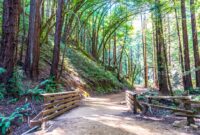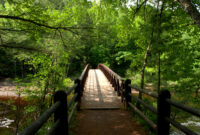Singles hiking trips offer a unique blend of personal challenge and social connection. Whether you’re a seasoned adventurer seeking solitude or a novice eager to meet like-minded individuals, exploring the trails alone or with newfound companions provides opportunities for self-discovery and breathtaking experiences. This guide delves into the planning, safety, and community aspects of singles hiking trips, equipping you with the knowledge and resources for unforgettable journeys.
From meticulously crafting itineraries and packing essential gear to navigating potential hazards and building trust with fellow hikers, we cover all the crucial elements for a successful and enriching experience. We’ll explore various destinations, compare different trip styles, and provide practical advice to help you maximize your enjoyment and minimize risks.
Trip Planning & Logistics for Singles Hiking Trips
Planning a solo hiking trip, especially in a challenging environment like the Rockies, requires careful consideration of logistics and safety. This section outlines key aspects to ensure a successful and enjoyable experience. Thorough preparation is paramount for a safe and rewarding adventure.
Sample 3-Day Rockies Hiking Itinerary
This itinerary focuses on a moderate-difficulty trip, adaptable to individual fitness levels. Always check weather conditions and trail closures before embarking on any hike.
Day 1: Easy Acclimatization Hike (Difficulty: Easy)
Morning: Arrive at trailhead (e.g., Bear Lake in Rocky Mountain National Park). Begin a gentle hike around Bear Lake, enjoying the scenery and acclimatizing to the altitude. This loop trail offers stunning views with minimal elevation gain. (Estimated time: 2-3 hours)
Afternoon: Relax at the campsite, set up your tent, and prepare dinner. Enjoy the peaceful surroundings and plan for the next day’s hike.
Evening: Stargazing and campfire (if permitted).
Day 2: Moderate Mountain Hike (Difficulty: Moderate)
Morning: Hike to Emerald Lake (or a similar trail based on fitness and preference). This involves a moderate elevation gain, offering spectacular views of alpine lakes and surrounding peaks. (Estimated time: 4-6 hours).
Afternoon: Enjoy a picnic lunch by the lake, take photos, and relax before heading back to the campsite.
Evening: Prepare dinner and rest.
Day 3: Scenic Valley Hike & Departure (Difficulty: Easy to Moderate)
Morning: Choose a shorter, scenic hike in a valley area. This could involve exploring a different trail near the campsite or returning to a previously visited location. (Estimated time: 2-3 hours).
Afternoon: Pack up camp, and begin your descent. Enjoy one last look at the majestic scenery before heading home.
Essential Gear Checklist for Singles Hiking Trips
Packing the right gear is crucial for a safe and comfortable trip. This checklist categorizes items by necessity and optional additions.
Essential Gear:
- Backpack (appropriate size for the trip length)
- Tent (lightweight and weatherproof)
- Sleeping bag (rated for expected temperatures)
- Sleeping pad
- Cooking stove and fuel
- Cookware and utensils
- Food and water (sufficient for the duration)
- First-aid kit (comprehensive and well-stocked)
- Navigation tools (map, compass, GPS device)
- Headlamp or flashlight (with extra batteries)
- Sunscreen, sunglasses, and hat
- Hiking boots (broken in and waterproof)
- Hiking poles (optional, but recommended for stability)
- Rain gear (jacket and pants)
- Layers of clothing (base layers, insulating layers, outer shell)
Optional Gear:
- Camera
- Binoculars
- Book or e-reader
- Camp chair
- Trekking poles
- Satellite communication device
Organized vs. Self-Organized Singles Hiking Trips: Benefits and Drawbacks
Both organized and self-organized trips offer unique advantages and disadvantages. The best choice depends on individual preferences, experience level, and comfort.
Organized Trips:
Benefits: Guided expertise, pre-planned itineraries, group camaraderie, logistical ease (transportation, permits, accommodation).
Drawbacks: Higher cost, less flexibility, potential for slower pace due to group dynamics.
Self-Organized Trips:
Benefits: Greater flexibility, lower cost, opportunity for solitude and self-discovery, setting your own pace.
Drawbacks: Requires more planning and preparation, increased responsibility for safety and logistics, potential for loneliness.
Cost Comparison: Self-Organized vs. Organized Singles Hiking Trip
This table provides a sample cost comparison, assuming a 3-day trip to the Rockies for one person. Actual costs can vary significantly based on specific choices and location.
| Cost Item | Self-Organized ($) | Organized ($) | Notes |
|---|---|---|---|
| Transportation | 100 (gas, parking) | 300 (shuttle, transport) | Depends on distance and chosen mode of transport. |
| Accommodation | 60 (camping gear, fees) | 450 (lodging, camping) | Organized trips often include higher-end accommodations. |
| Food | 75 (groceries) | 150 (meals provided) | Self-organized allows for cost-effective meal planning. |
| Gear Rental/Purchase | 50 (if needed) | 0 (usually included) | Organized trips often provide necessary gear. |
| Permit/Fees | 25 (park entrance, permits) | 50 (included in package) | Organized trips handle permit acquisition. |
| Guide/Leader | 0 | 300 (guide fees) | Organized trips usually have professional guides. |
| Total Estimated Cost | 310 | 1250 | Costs are estimates and can vary significantly. |
Safety & Risk Management on Singles Hiking Trips
Solo hiking offers unparalleled freedom and connection with nature, but it also necessitates a heightened awareness of safety and risk. Successfully navigating the potential challenges requires careful planning, preparedness, and a proactive approach to risk mitigation. This section details crucial safety measures for solo hikers, emphasizing navigation, communication, and emergency preparedness.
Navigation and Trail Awareness
Accurate navigation is paramount when hiking alone. Prior to your hike, thoroughly research your chosen trail, noting its length, elevation gain, difficulty, and any known hazards. Obtain a detailed map and compass, and ideally learn how to use them effectively. Familiarize yourself with the trail’s markings and alternative routes. Consider downloading offline maps and GPS apps onto your phone, ensuring it’s fully charged. Regularly check your position against your map and compass, especially at trail junctions or points where the trail may be less clear. Being aware of your surroundings, noting landmarks, and having a backup plan in case of getting lost are crucial components of safe navigation. For example, if you are unsure about a trail split, consider retracing your steps to a known point before proceeding.
Communication and Contact Maintenance
Maintaining consistent communication is vital in case of an emergency. Inform a trusted friend or family member of your hiking plans, including your chosen trail, estimated start and finish times, and emergency contact information. Establish regular check-in times and stick to them. If you are unable to check in at the designated time, your contact person will know to initiate a search. Consider carrying a satellite messenger or personal locator beacon (PLB), devices that can send emergency signals even without cell service. A fully charged cell phone is essential, though its reliability in remote areas can be limited.
Emergency Preparedness and First Aid
Preparing for unexpected events is crucial. Carry a comprehensive first-aid kit tailored to potential hiking injuries, including items such as bandages, antiseptic wipes, pain relievers, and blister treatment. Pack extra food and water, beyond your estimated needs, to account for delays or unexpected circumstances. A lightweight emergency blanket can provide vital warmth in colder temperatures or unexpected weather changes. Knowing basic first aid and wilderness survival techniques can significantly improve your chances of survival in an emergency situation. For example, understanding how to treat a sprained ankle or build a makeshift shelter could be lifesaving.
Potential Hazards and Mitigation Strategies
Hiking trails present various hazards. Weather changes can be sudden and severe; be prepared for rain, wind, extreme heat, or cold. Wildlife encounters, such as encounters with bears or snakes, are possible; learn how to react appropriately to minimize risk. Trail obstacles like slippery rocks, fallen trees, or steep inclines demand caution and appropriate footwear. Navigation errors can lead to disorientation and delays. To mitigate these risks, check the weather forecast before you leave, carry appropriate clothing and gear, learn about local wildlife and their behavior, wear sturdy hiking boots, and practice safe navigation techniques. Carrying bear spray in bear country is a wise precaution.
Emergency Response Procedures
A flowchart illustrating emergency response steps is essential:
[Imagine a flowchart here. The flowchart would begin with a box labeled “Emergency Encountered?”. A “Yes” branch would lead to a series of boxes: “Assess Situation,” “Activate Emergency Beacon/Call for Help,” “Administer First Aid,” “Find Safe Shelter,” “Signal for Rescue,” “Stay Calm and Conserve Energy.” A “No” branch would lead to a box labeled “Continue Hike.” The flowchart would end with a box labeled “Rescue/Safe Return.”]
Finding Hiking Companions & Building Community
Finding reliable and compatible hiking partners is crucial for enjoyable and safe solo hiking trips. Building a strong community of fellow outdoor enthusiasts can significantly enhance the experience, transforming potentially solitary adventures into shared memories. This section outlines effective methods for connecting with potential hiking companions, both online and offline, while emphasizing safety and compatibility.
Finding Hiking Companions Online
The internet offers a wealth of resources for connecting with like-minded individuals who share a passion for hiking. Online platforms provide opportunities to find potential hiking partners based on shared interests, experience levels, and geographical locations. It’s important to prioritize safety and verify the credibility of potential partners before engaging in any in-person activities. This includes using reputable platforms and conducting thorough background checks when appropriate.
Examples of Online Platforms for Singles Hiking
Several online communities cater specifically to singles interested in hiking and outdoor activities. Meetup.com, for example, boasts numerous groups dedicated to hiking, often with subgroups focusing on skill level or geographical area. Facebook groups, such as those dedicated to hiking in specific regions or for specific skill levels, offer another avenue for connection. Additionally, specialized outdoor recreation websites and apps, such as AllTrails or Hiking Project, often include social features that allow users to connect with others planning hikes in similar locations. These platforms often incorporate safety features, such as requiring profile verification or allowing users to share their trip plans with trusted contacts.
Building Trust and Rapport with Potential Hiking Companions
Establishing trust and rapport with potential hiking companions is essential before embarking on a trip together. Open communication is key; clearly state your experience level, hiking goals, and expectations for the trip. Consider having a virtual introductory call or video chat before meeting in person to assess compatibility and build a sense of comfort. Sharing detailed trip plans, including routes, estimated times, and emergency contact information, demonstrates responsibility and enhances safety. Participating in smaller group hikes or day trips before committing to longer, more challenging adventures allows for a gradual build-up of trust and a better understanding of each other’s hiking styles and preferences.
Icebreaker Questions for Potential Hiking Partners
Before embarking on a hiking trip together, engaging in casual conversation can help determine compatibility and build rapport. The following icebreaker questions are designed to facilitate open communication and gauge shared interests and expectations:
- What is your experience level with hiking?
- What are your favorite types of hikes (e.g., day hikes, backpacking, etc.)?
- What are your fitness goals for hiking?
- What is your preferred pace on a hike?
- What are your expectations for communication during a hike?
- What are your preferred methods of navigation?
- What is your approach to risk management during a hike?
- What is your experience with emergency situations in the outdoors?
Post-Trip Reflections & Sharing Experiences
A solo hiking trip offers a unique opportunity for self-discovery and personal growth. The experience extends beyond the physical challenge; it’s a chance to reconnect with nature, reflect on life, and cultivate a deeper understanding of oneself. Documenting and sharing these experiences not only preserves precious memories but also allows for growth and connection with a wider community of hikers.
Post-trip reflection is crucial for both personal development and future planning. Analyzing the successes and challenges encountered on a solo hike provides valuable insights for enhancing future adventures. Sharing these experiences, in turn, fosters a sense of community and inspires others to embark on their own journeys.
Documenting and Sharing Hiking Experiences
Several methods effectively capture and share the essence of a solo hiking trip. Journaling allows for a personal and detailed account of daily events, emotions, and observations. Photography provides a visual record of breathtaking landscapes and memorable moments. Blogging allows for a more comprehensive narrative, incorporating both written reflections and visual elements. These approaches, used individually or in combination, ensure a rich and multifaceted record of the journey.
Examples of Compelling Hiking Narratives
A compelling narrative might detail the unexpected encounter with a wildlife, such as a majestic deer grazing peacefully in a sun-dappled meadow, highlighting the tranquility and unexpected beauty encountered. Another compelling narrative could focus on overcoming a personal challenge, like conquering a particularly steep incline, emphasizing the sense of accomplishment and resilience developed. A third example could describe the awe-inspiring panorama witnessed from a mountain summit, detailing the emotional impact of the expansive view and the feelings of freedom and perspective gained. These narratives showcase the multifaceted nature of solo hiking experiences, emphasizing both the physical and emotional aspects.
Benefits of Reflecting on a Hiking Trip
Reflecting on a solo hiking trip offers numerous benefits. It allows for an objective assessment of preparedness, identifying areas where gear or planning could be improved. Reviewing physical fitness levels and pacing strategies helps in planning future hikes that align better with personal capabilities. Furthermore, introspection into emotional responses to challenges and successes on the trail contributes to personal growth and self-awareness. By honestly assessing the trip’s successes and shortcomings, a hiker can refine their approach and enjoy more fulfilling future experiences.
Tips for Engaging with Fellow Hikers Online
Sharing experiences with fellow hikers online can build a supportive and encouraging community. Participating in relevant online forums or social media groups dedicated to hiking allows for the exchange of tips, advice, and stories. Sharing photos and detailed trip reports can inspire others and spark conversations. Actively responding to posts and comments fosters a sense of connection and mutual support. Respectful and constructive engagement is key to building a positive online community. Remember to follow community guidelines and prioritize respectful interactions.
Conclusive Thoughts
Embarking on a singles hiking trip is an investment in personal growth and a chance to forge lasting connections with nature and other individuals. By carefully planning, prioritizing safety, and embracing the community aspect, you can unlock a world of rewarding adventures. Remember to document your experiences, reflect on your journey, and share your stories – inspiring others to explore the incredible world of solo and group hiking.




